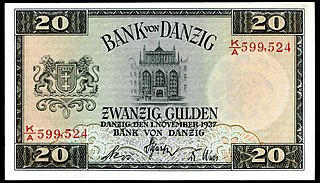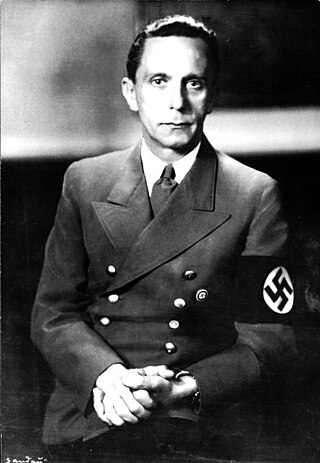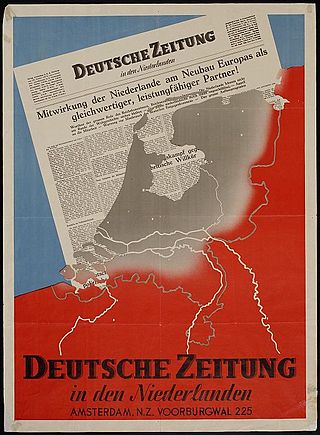Related Research Articles

Der Stürmer was a weekly German tabloid-format newspaper published from 1923 to the end of World War II by Julius Streicher, the Gauleiter of Franconia, with brief suspensions in publication due to legal difficulties. It was a significant part of Nazi propaganda, and was virulently anti-Semitic. The paper was not an official publication of the Nazi Party, but was published privately by Streicher. For this reason, the paper did not display the Nazi Party swastika in its logo.

The Frankfurter Zeitung was a German-language newspaper that appeared from 1856 to 1943. It emerged from a market letter that was published in Frankfurt. In Nazi Germany, it was considered the only mass publication not completely controlled by the Propagandaministerium under Joseph Goebbels.

The Frankfurter Rundschau (FR) is a German daily newspaper, based in Frankfurt am Main.The Rundschau's editorial stance is social liberal. It holds that "independence, social justice and fairness" underlie its journalism. In Post-war Germany Frankfurter Rundschau was for decades a leading force of German press. Die newspaper was one of the first, which get licencened by the US military administration in 1945 and had a traditional stabel social democratic, antifastic and trade union stand. Starting with the decline of printed daily newspapers in the 2000s, the FR changed ownership several times, reduced its editorial team dramatically and today has little national significance.
The Vossische Zeitung was a nationally known Berlin newspaper that represented the interests of the liberal middle class. It was also generally regarded as Germany's national newspaper of record. In the Berlin press it held a special role due to the fact that by way of its direct predecessors it was the oldest newspaper in the city. The name went back to Christian Friedrich Voss, who was its owner from 1751 to 1795, but Vossische Zeitung became its official name only after 1911. It ceased publication in 1934 under pressure from the Nazi state.

The German National Library is the central archival library and national bibliographic centre for the Federal Republic of Germany. It is one of the largest libraries in the world. Its task is to collect, permanently archive, comprehensively document and record bibliographically all German and German-language publications since 1913, foreign publications about Germany, translations of German works, and the works of German-speaking emigrants published abroad between 1933 and 1945, and to make them available to the public. The DNB is also responsible for the Deutsche Nationalbibliografie and several special collections like the Deutsches Exilarchiv 1933–1945, Anne-Frank-Shoah-Bibliothek and the Deutsches Buch- und Schriftmuseum. The German National Library maintains co-operative external relations on a national and international level. For example, it is the leading partner in developing and maintaining bibliographic rules and standards in Germany and plays a significant role in the development of international library standards. The cooperation with publishers has been regulated by law since 1935 for the Deutsche Bücherei Leipzig and since 1969 for the Deutsche Bibliothek Frankfurt am Main.
German Australians are Australians with German ancestry. German Australians constitute one of the largest ancestry groups in Australia, and German is the fifth most identified European ancestry in Australia behind English, Irish, Scottish and Italian. German Australians are one of the largest groups within the global German diaspora.

The gulden, divided into 100 Pfennige, was the currency of the Free City of Danzig from 1923 to 1939.
Deutsche Zeitung in Norwegen was an Oslo-based daily newspaper published in Norway during the Second World War. It was published by the subsidiary Europa-Verlag of the Nazi-controlled Franz Eher Nachfolger, and had a circulation of about 40,000 copies. The paper served as a model for the Amsterdam-based Deutsche Zeitung in den Niederlanden.

The Reich Ministry for Public Enlightenment and Propaganda, also known simply as the Ministry of Propaganda, controlled the content of the press, literature, visual arts, film, theater, music and radio in Nazi Germany.

The New Yorker Staats-Zeitung, nicknamed "The Staats", claims to be the leading German-language weekly newspaper in the United States and is one of the oldest, having been published since the mid-1830s. In the late 19th century, it was one of New York City's major daily newspapers, exceeded in circulation only by the New York World and the New-York Tribune. Among other achievements, as of its sesquicentennial anniversary in 1984 it had never missed a publication date, thereby laying claim to the title of being continuously published longer than any other newspaper in America.

The Deutsche Zeitung in den Niederlanden was a German-language nationwide newspaper based in Amsterdam, which was published during almost the entire occupation of the Netherlands in World War II from June 5, 1940 to May 5, 1945, the day of the German capitulation in the "Fortress Holland". Its objective was to influence the public opinion in the Netherlands, especially the one of the Germans in this country.
Kurt Dahlmann was a German pilot, attorney, journalist, newspaper editor and political activist. He was also a recipient of the Knight's Cross of the Iron Cross with Oak Leaves of Nazi Germany.

Fritt Folk was a Norwegian newspaper, published in Oslo. It was the official organ of the fascist party Nasjonal Samling, and came to prominence during the Second World War.
The National-Zeitung was a weekly, far-right newspaper, published by Gerhard Frey, who also founded the far-right Deutsche Volksunion as an association in 1971, turning it into a political party in 1987. The party was merged with the National Democratic Party of Germany (NPD). NZ was last published in December 2019.

Der Ostasiatische Lloyd (OAL) was a German language newspaper published in Shanghai, China. It served as the oldest German language newspaper in China. German communities in China and Southeast Asia read the newspaper. It was considered to be the highest quality German language newspaper in China. Most of the content focused on economics and politics, while it also had some cultural pages.

Deutsche Adria-Zeitung was a German-language daily newspaper published from Trieste. The first issue was published on 14 January 1944. The newspaper was published seven times a week and had a weekly supplement called Adria-Illustrierte. Deutsche Adria-Zeitung was discontinued in May 1945.
Gerd R. Ueberschär is a German military historian who specialises in the history of Nazi Germany and World War II. He is one of the leading contributors to the series Germany and the Second World War and, together with Rolf-Dieter Müller, is the author of Hitler's War in the East 1941−1945: A Critical Assessment. Both works have been published in English translations.
Horst Boog was a German historian who specialised in the history of Nazi Germany and World War II. He was the research director at the Military History Research Office (MGFA). Boog was a contributor to several volumes of the seminal work Germany and the Second World War from the MGFA. He was an expert on the Luftwaffe and the German side of the aerial war in Europe during World War II.

Die Deutsche Frauen-Zeitung was a German language newspaper founded in 1852 by Mathilde Franziska Anneke in Milwaukee. The paper focused on women's rights issues and ran for around two and half years. It was one of the first feminist journals produced by a woman in the United States.
References
- ↑ Sylvia Asmus (2006-06-28). "Erläuterungen: Die Zeitung" (in German). Deutsche Nationalbibliothek. Archived from the original on 2012-02-14. Retrieved 2009-05-31.